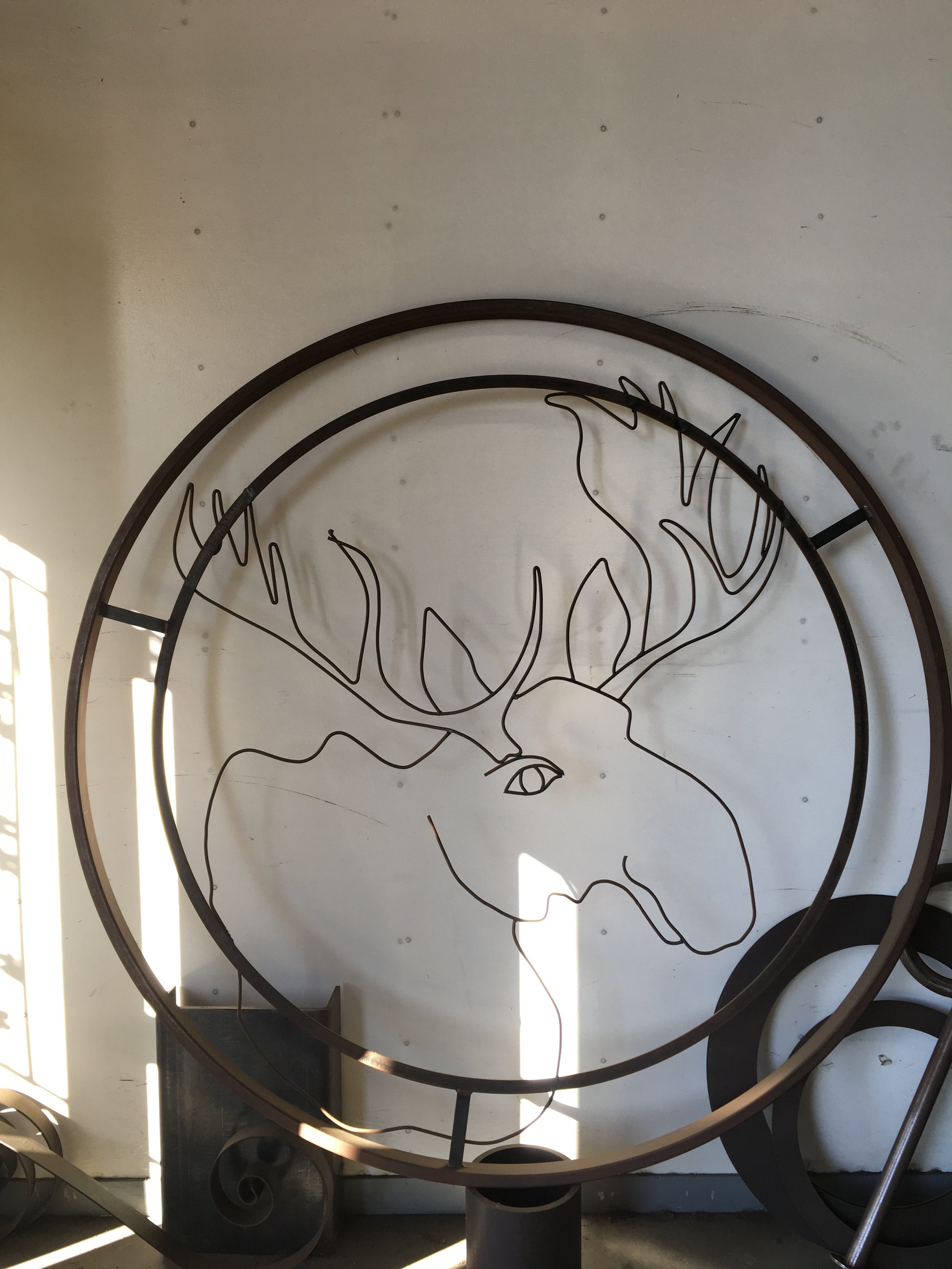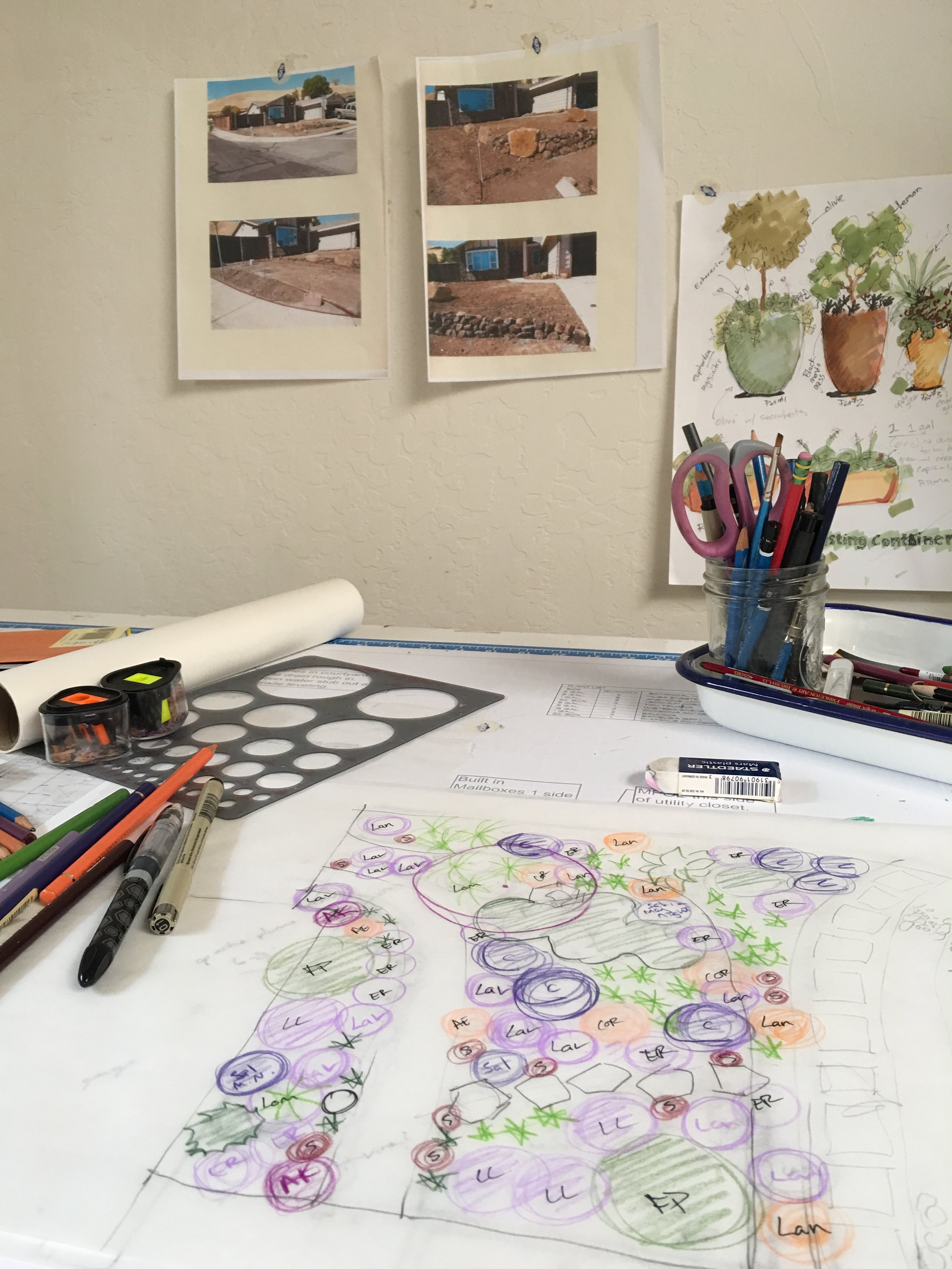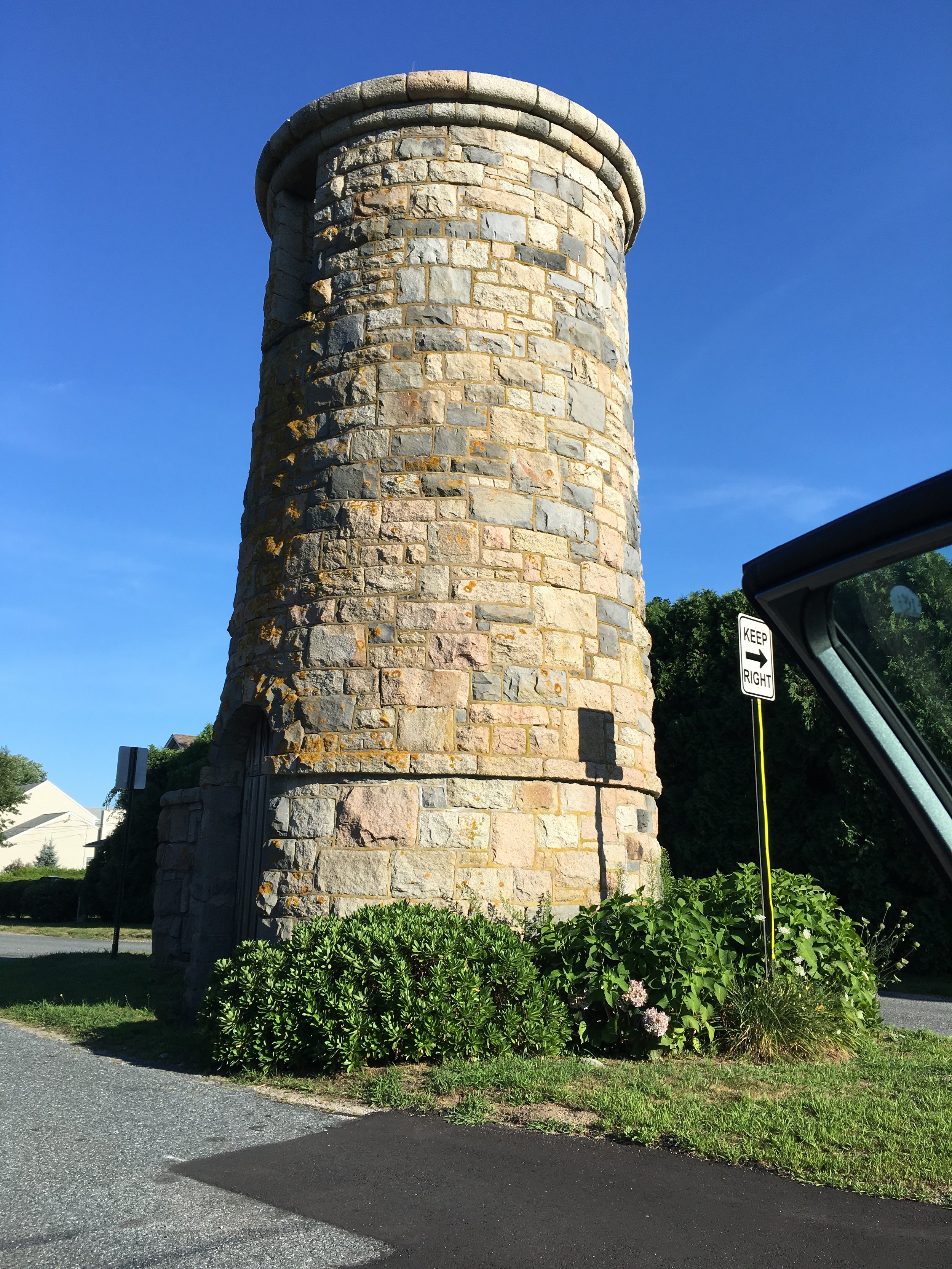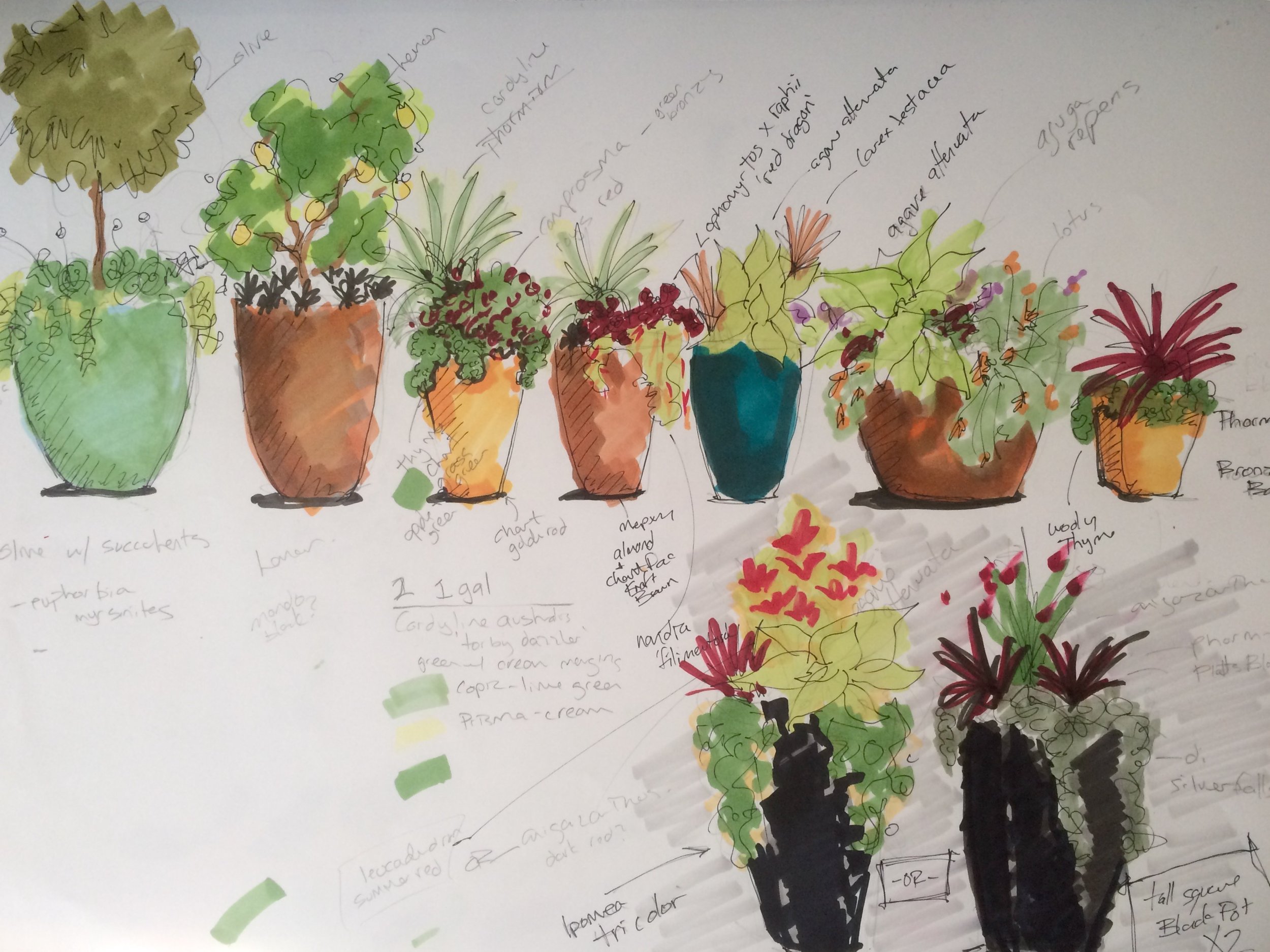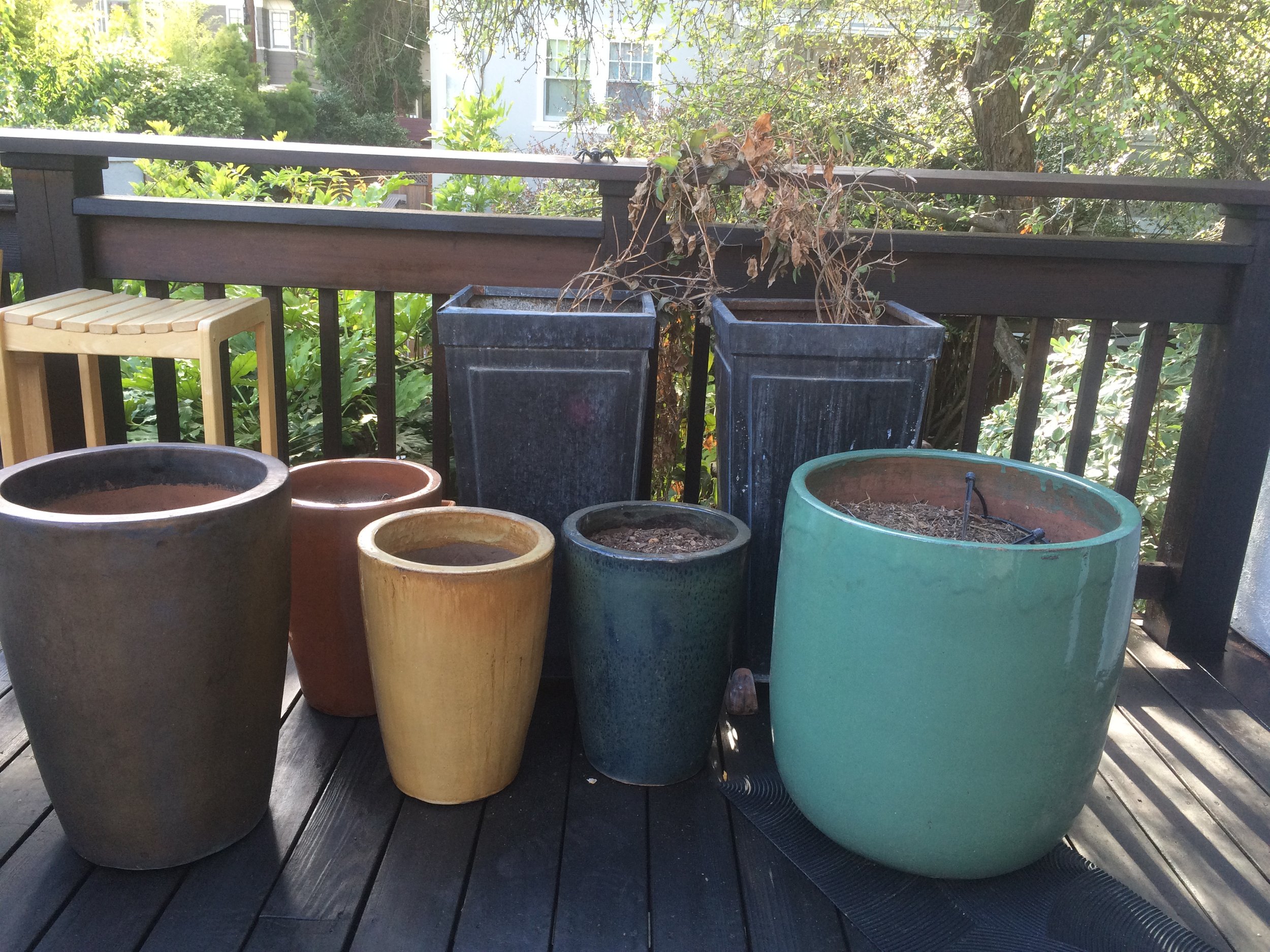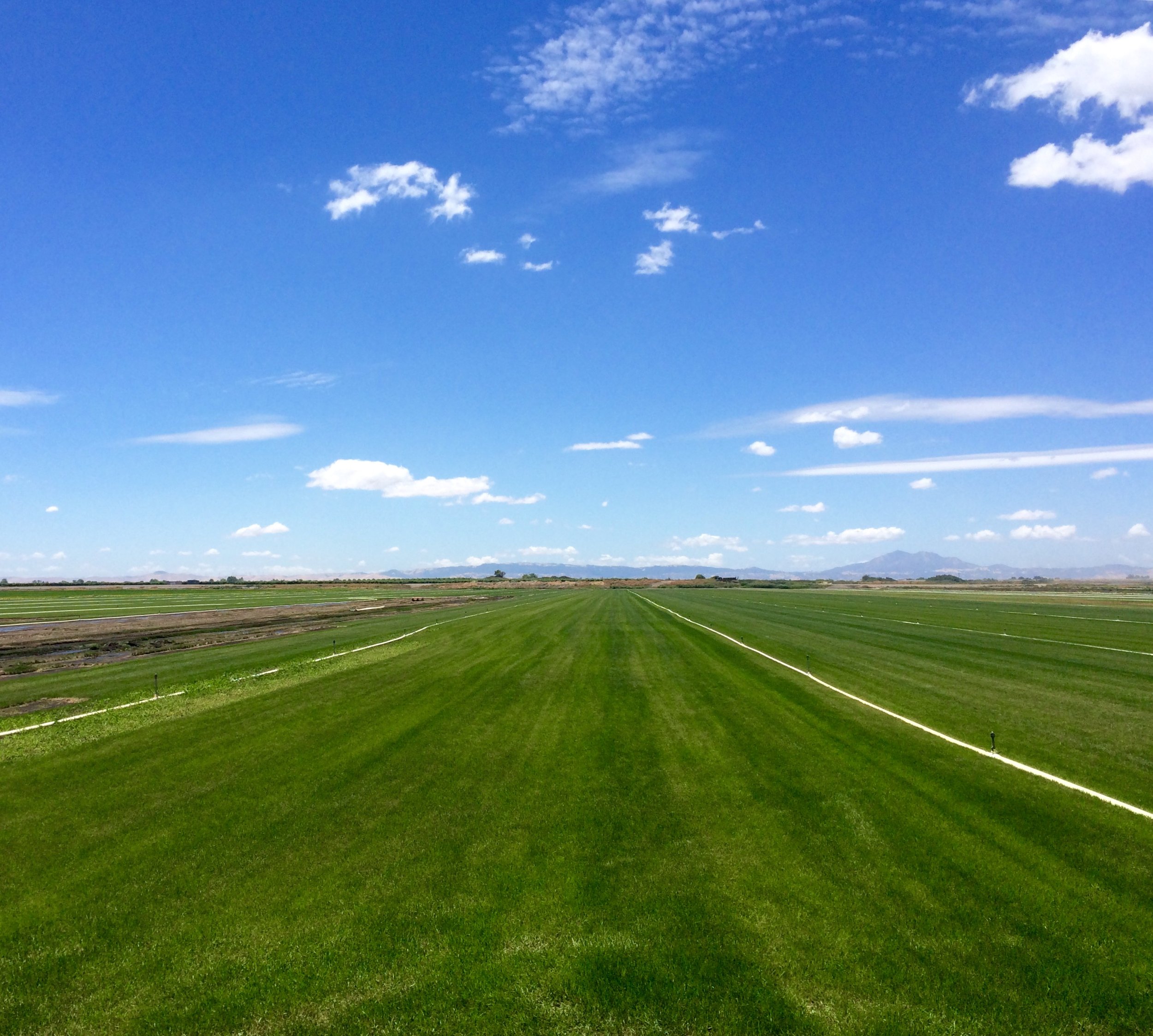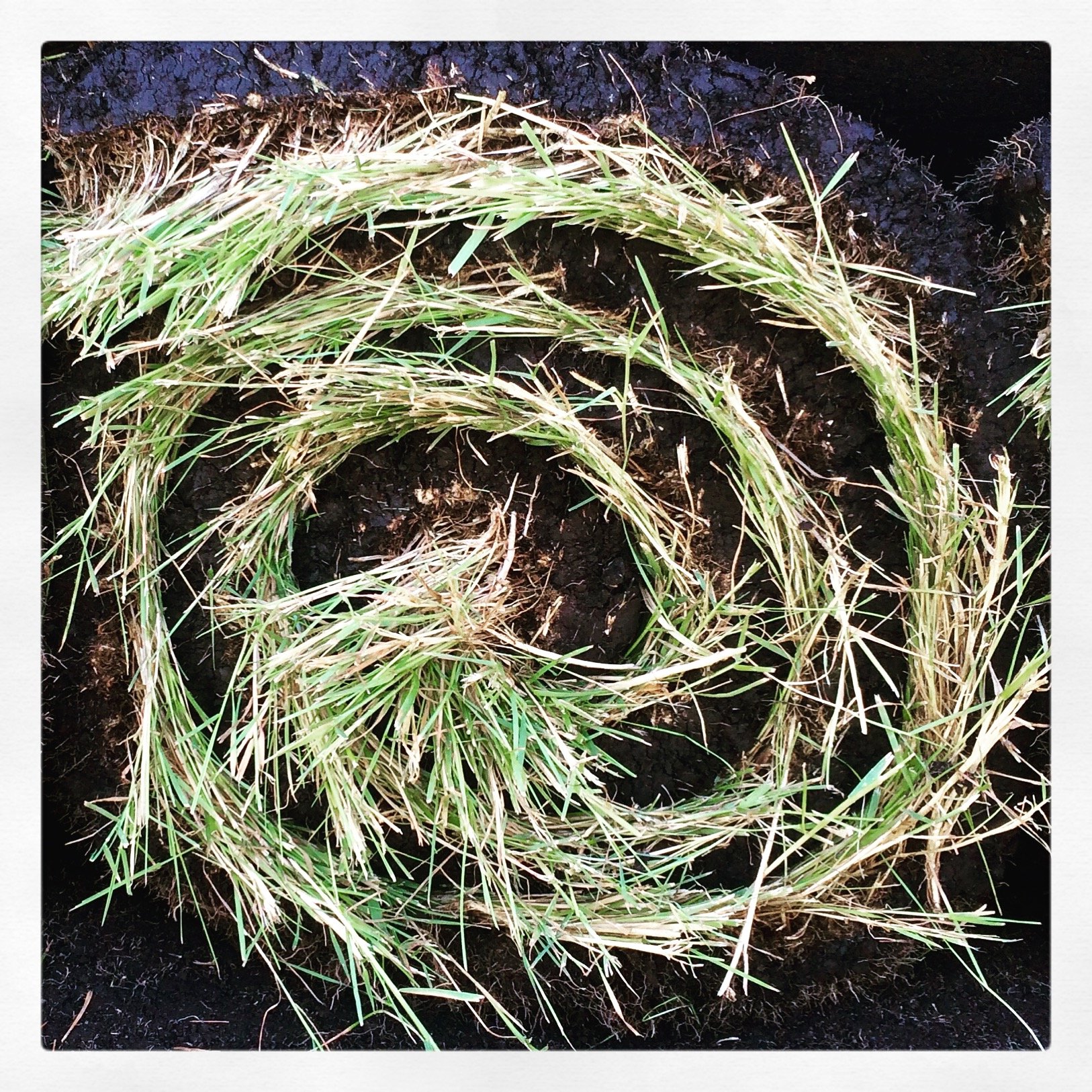I’m really loving all these storm water solutions I am seeing in Walnut Creek parking lots. :D I wish there were some regulations in Texas for this kind of thing. Every time I go back there I am so offing appalled by the infrastructure. Or lack thereof, I guess. Have fun with building a whole city in a swamp and then refusing to acknowledge that and have some regulations for infrastructure. Jerks. I hate Texas.
A Visit to Moose Metal in Concord
I stopped by Moose Metal to inquire about a metal project for a client. How cute is this metal moose logo?!
It was a wealth of fun metal detritus for me to snap pics of.
Many shapes and colors!! I really, really want to include colorful metal elements in my landscape designs. My pinnacle of silly landscape color you ask? I bright pink arbor. I want one myself so surely everyone else will, right?!
More cute moose themed items :)
Right Tree, Right Place
This is a handy tree guide made up for PGE by California Polytechnic State University for the Bay Area, Northern and Central California. If you're working on a site with power line issues this tool can be quite useful.This page has some handy guides for selecting the right tree for the right place based on some other guidelines like allergy and toxicity or fire safety.
You can order a Right Tree, Right Place poster from PGE here and download a cute poster for Palm trees appropriate for use near power lines.
The people who planted redwoods right next to the power lines at a recent client's property could have used this guide 15 years ago...
Getting settled in my new office
Settling in to my new office in Emeryville. The construction at my house is… very disruptive. I was working upstairs the other day and they LIFTED and DROPPED the entire house. LOL. I was def. startled. I’ll be excited to have a basement, for sure.
Pretty Little Grass - Melinis nerviglumis
This is such a pretty grass! I have one that I got from Annies Annuals. Devil Mountain has it listed as Rhynchelytrum nerviglumis but I have only seen it as Melinus nerviglumis. It’s not exactly low water but I really love the soft pink plumes.
From San Marcos Growers site:
Melinis nerviglumis (Ruby Grass) - A small semi-evergreen cool-season grass from S. Africa that forms a tidy 1 foot tall clump. It has blue-green foliage that turns purplish-red in the fall and showy pink flowers that rise a foot above the foliage in the spring and summer with spent flowers still attractive into winter. Best in full sun with regular water in a well-drained soil but tolerates considerable periods without irrigation and near seaside conditions. Is hardy to around 20° F and perennial in gardens in USDA Zones 8 and above but useful as an annual in colder climates. Cut back in fall to midwinter to allow fresh new foliage to emerge in early spring. A very attractive grass massed or scattered in a border planting or as a container specimen. This grass is called "one of the showiest of the small flowering grasses" by John Greenlee in his "Encyclopedia of Flowering Grasses". Ruby Grass is native to large areas of Africa south of the Sahara and also in Madagascar. There are several interpretations for the entomology of the genus name. One thought is that it is derived from the Greek 'melas' meaning "black" for its black seeds but another thought is that it is from the Latin 'mel' meaning honey for the sweet aroma some species have. The specific epithet is in reference to the veins on the glume (flower bracts). We have grown this plant since 1997 and early on used its older name Rhynchelytrum neriglume. This same plant is marketed under the names 'Pink Crystals' and 'Savannah' and besides Ruby Grass is commonly called Bristle-leaved Red Top. It should not be confused with the related Melinis repens that has naturalized in disturbed sites along the California coast.
2016 APLD International Conference
I had a fantastic time at my second APLD Conference. It was wonderful to reconnect with friends from last year and see familiar faces from the Bay Area.
Just outside the hotel was the Santa Fe Railyard Park. The park featured beautiful hardscape and plant designs, a children's play area, and lovely gardens. I particularly admired how the designers incorporated the railroad tracks and other historical railroad elements into the park's design.
Right from the start, I was so excited that the keynote speaker was W. Gary Smith, the author of From Art to Landscape: Unleashing Creativity in Garden Design. I totally fangirled a bit and brought my copy of his book for him to sign. He was super nice and signed my book for me. Gary is an accomplished landscape designer, having won APLD Garden Awards and worked on many renowned gardens. Coming from an art and design background myself, his book really attracted me and I often refer to it.
These are in no particular order. I’m just dumping photos.
Check out these interesting gabions. They are partially filled with glass slag chunks! Neat!
This garden just had a TON of amazing architectural details. I love to fun round pavers, the colors! The whole thing!
Pleasant Hill, CA Rasputin Music Green Roof and Landscaping
I'm just starting to drive around the far East Bay (i.e. Walnut Creek, Pleasant Hill, etc). I drove buy this Rasputin Records Shop the other day and was kind of surprised to see the nice landscaping and green roof! I stopped to snap a few pics and I probably should have run in to ask who did their landscaping. Next time!
Anywho, how cute is this?! Do I see some invasive grasses? Yes. I am trying to ignore them though. :)
Discovering the Extraordinary Playscapes Exhibit
During our trip, we had a totally unexpected but amazing moment. We stumbled upon The Boston Society for Architecture's Extraordinary Playscapes exhibit while walking around Boston. As someone obsessed with playscapes, I was thrilled by this discovery!
The Science of Play
The exhibit was extensive, filled with information mostly about commercial play spaces but also delving into the reasons for play and how play spaces influence child development. There were interactive exhibits, outdoor installations that I couldn’t visit, and plenty of beautiful drawings, plans, and models.
We spent a lot of time at the "Imagination Playground" exhibit by David Rockwell. This featured large blue foam blocks that you could manipulate. Much like small-scale building blocks, these large ones allowed you to create your own world and build your space. I loved how these blocks enabled people (kids and adults) to interact in various ways. Whether you’re a builder, a zoomer, or a quiet hider, you could use these blocks to play for hours.
I just love plan view drawings. They are one of the reasons I was attracted to the career. :D.
Nature play is near and dear to my heart. Not only did I create a forest pre school for my kid but I also worked on the play environment at his k-8 school. I also have a whole workshop I have taught at the Mothership Hackermoms in Berkeley.
Here is a link with exhibit info:
https://www.architects.org/exhibitions/extraordinary-playscapes
https://www.architects.org/about/bsa-space/visit
Pots and Fountains Resources
I'm working on lists for various landscape resources. Online and local to the Bay Area, CA.Here we have some fountain and pot resources.
APLD Plant Fair
Sadly, I didn't manage to take enough photos during the APLD Bay Area District Plant Fair. Next time, I must remember to capture some overview and crowd shots!
The APLD Bay Area Plant Fair is a fantastic event where growers and nurseries come together to showcase their latest and most popular plants. It's a great opportunity for landscape designers and plant enthusiasts to learn about new varieties and get expert advice on plant care and cultivation. I always enjoy attending and hearing the detailed stories and tips from the growers. It’s a fun and informative event that highlights the best of what our local nurseries have to offer.
I won this in the raffle. Now I need to figure out what to do with it!
I would also like to send a shout out to the amazing APLD Bay Area Board Members and Volunteers who pout this event on. Thank you so much for all your work!
Earls's Court Water Tower in Narragansett Rhode Island
I spent all my summers growing up in Narragansett, Rhode Island. I still have family there, and my parents often rent a beach house for a couple of weeks, graciously letting me join them and take over their vacation time. The beach is my happy place.
One of my favorite landmarks is an old water tower just a street over from my grandparents' house. I always found it enchanting, with a fairy tale-esque and mysterious charm. One day, my grandfather took me there with my sketchpad and favorite Ebony Pencil while he brought along a folding lawn chair. He sat and watched as I drew the tower. At the time, I was a bit put out—did I really want to sit and draw while he watched me? But looking back, I realize he was nurturing my natural inclination to draw, even after years of trying to get me to throw a ball with him. I still have that drawing somewhere and plan to dig it out someday.
On my recent visit, I sat awkwardly in my car and sketched the tower in my sketchbook again. It brought back a lot of memories.
In Praise of Ebony Pencils
A quick shout-out to Ebony Pencils: they're perfect for sketching with their rich, dark lines. If you haven't tried one, I highly recommend it! I absolutely loved these things when I was a kid!
History of the Earl's Court Water Tower
While Googling the tower, I found a fascinating photo on the Library of Congress website (link: Library of Congress). It's amazing how different it looked back then!
According to Wikipedia, the Earl's Court Historic District is a residential historic area in Narragansett, Rhode Island. It centers on Earles Court, between Gibson Avenue and Noble Street, and includes several properties on adjacent streets. The district features nine residential properties developed in the 1880s and 1890s, during the height of Narragansett Pier's popularity as a summer resort. Most buildings are in the Shingle Style, designed by well-known architects. Notably, the Sherry Cottages on Gibson Avenue were designed by McKim, Mead & White, who also designed The Towers. The development on Earles Court, designed by D. J. Jardine and Constable Brothers for New York lawyer Edward Earle, features a stone water tower as its central focus.
This beautiful old water tower is a testament to the rich history and architectural beauty of Narragansett. It’s fascinating to think about how it once stood proudly as part of a bustling resort community and continues to capture the imagination today.
Exploring MIT: A Glimpse into T**'s Alma Mater
During our East Coast visit, we spent some time on the MIT campus. It was really lovely to see where T** went to school and to show J*** around. The campus is beautiful. T** shared a fantastic story about dropping thousands of super balls from the ceiling of one of the buildings. We’ll leave out the environmental impact of that little adventure!
This might be the building he was talking about.
We came across signage for a rainwater harvesting project that was quite impressive. It’s great to see these types of initiatives on a college campus, inspiring young minds. This project features a 50,000-gallon cistern, and all the collected water is used for flushing toilets and landscaping irrigation around the building. Here isn article from 2009 about it.
Rainwater Harvesting at The Strata Center
We came across signage for a rainwater harvesting project that was quite impressive. It’s great to see these types of initiatives on a college campus, inspiring young minds. This project features a 50,000-gallon cistern, and all the collected water is used for flushing toilets and landscaping irrigation around the building. Here isn article from 2009 about it.
We also admired a rock wall memorial, complete with a water feature and seating area. I like how the rock retaining wall follows the form of the built up soil behind it.
The campus had some gabions in use as well. For those who are unfamiliar, a gabion is a wire container filled with rocks, which can be construction waste like broken concrete or other large rocks. They can serve as seating if you add a nice cap, and as retaining walls if you include a barrier on the retaining side. My feelings about gabions are mixed. While they’re an excellent way to keep broken concrete out of landfills, they need to be filled with pieces that fit well and look nice, which can add time and labor to a project. Moreover, there’s the concern about little fingers getting caught or small rodents and spiders making homes in them. However, with the right client willing to cover the extra effort, they can be a sustainable and attractive option.
The weather was incredibly humid, something I'm not used to anymore! I do love the East Coast though. Later we will meet up with some old friends and then we are off to RI, one of my favorite places!
Useful Resource!
I love this useful Botanic Latin name pronunciation guide: overplanted.com - Botanical Latin Pronunciation GuideI just used this too look up Bulbine frutescens - bul-BYE-nee froo-TESS-enzI WAS saying it correctly, so good for me. But I was with someone recently who was not pronouncing the -nee at the end.
Pots on a Deck
This area is quite hilly, and many homes feature decks with stunning views. In some cases, the backyard slopes so steeply that a deck is the only way to fully enjoy the outdoor space. Beautifully designed plant containers can enhance the deck experience, surrounding you with nature and making it even more enjoyable.
I love designing pot vignettes. Selecting pots with harmonious colors and appropriate sizes is crucial. Tiny pots on a large deck or oversized pots on a small deck can frustrate clients and detract from the overall deck experience.
Container shopping can be quite enjoyable, whether you're doing it alone or with clients. It's essential to invest in high-quality containers. From my observations of various client landscapes, I've noticed many small, cheap, and abandoned containers cluttering their side yards. I really don’t love the fiberglass containers I keep seeing. Pottery store inventory can change frequently, so it's important to shop and purchase your pots in a timely manner.
I love the other garden ornaments you can find. Concrete cats, pigs, chickens, etc.
Plants ready to get installed into new homes!
A selection of pots about to get planted up. In the background there you can see two crappy older fiberglass (or plastic even) pots that have simply failed at the seams. They will get hauled off and dumped. We replaced them with nicer ceramic containers in the same basic shape. I love this color palette.
People can get serious sticker shock when it comes to buying contains. Jaws hit the floor, etc. I like to emphasize that they will lat a lifetime and beyond.
A visit to Delta Bluegrass
If you are looking for quality sod in the Bay Area Delta Bluegrass is the place to go.
In the droughty Bay Area, we're encouraging people to remove their lawns. While there is a time and place for some lawn in a residential setting, it's often overemphasized. A common misconception is that families with kids need a huge lawn for play. In my opinion, this is a myth. Lawns are large, monotonous spaces that can limit play opportunities for children. A sprawling lawn might be useful if a child is passionate about soccer or another ball sport, but otherwise, it doesn't offer much in terms of stimulating play and I’m just not into it at all!
That said, a small patch of lawn can be nice, I admit! However, if you simply want a cool, grassy spot to relax with a glass of wine, a meadow is a far better option. Picture an Adirondack chair under dappled shade, with your bare feet in a soft, lush meadow—that's my idea of heaven. OR, picture a couple o tree stumps set up to be a table and chairs and your small children gathered around adding items like pine cones or flowers or rocks to the “table”. Anyway, meadows not only provide a more diverse and interesting landscape with ‘scope for the imagination’ - to quote Anne of Green Gables, but they also support local biodiversity and require less maintenance than traditional lawns.
But, again, there is a place for lawns even in the Bay Area. And there are low water and native options and that is why I am at Delta Bluegrass to hear about them all.
Rolls of Sod at teh Delta Bluegrass growing grounds.
Kurapia! Kurapia is a ground cover plant developed (I think developed in Japan?) from Lippia nodiflora. Kurapia is a low-maintenance, drought-tolerant ground cover that is being used as an alternative to traditional lawns. It requires less water, fertilizer, and mowing compared to typical grass lawns, making it an environmentally friendly option. Kurapia also has strong resistance to pests and diseases and can handle a wide range of soil types, making it versatile for various landscaping needs. Its ability to establish quickly and provide a dense, green coverage makes it an appealing choice for residential and commercial landscapes. It fills in quickly and WILL overrun sidewalks/hardscapes. It works well in shade as well as sun. In the sun this is not great if you have lids and pets running about because it will be absolutely COVERED in bees. In shade it does not flower much.
They have a handy dandy installation exhibit of various sods
The sod cutting and rolling machines were badass. I love weird industrial equipment. They also fed us lunch!


